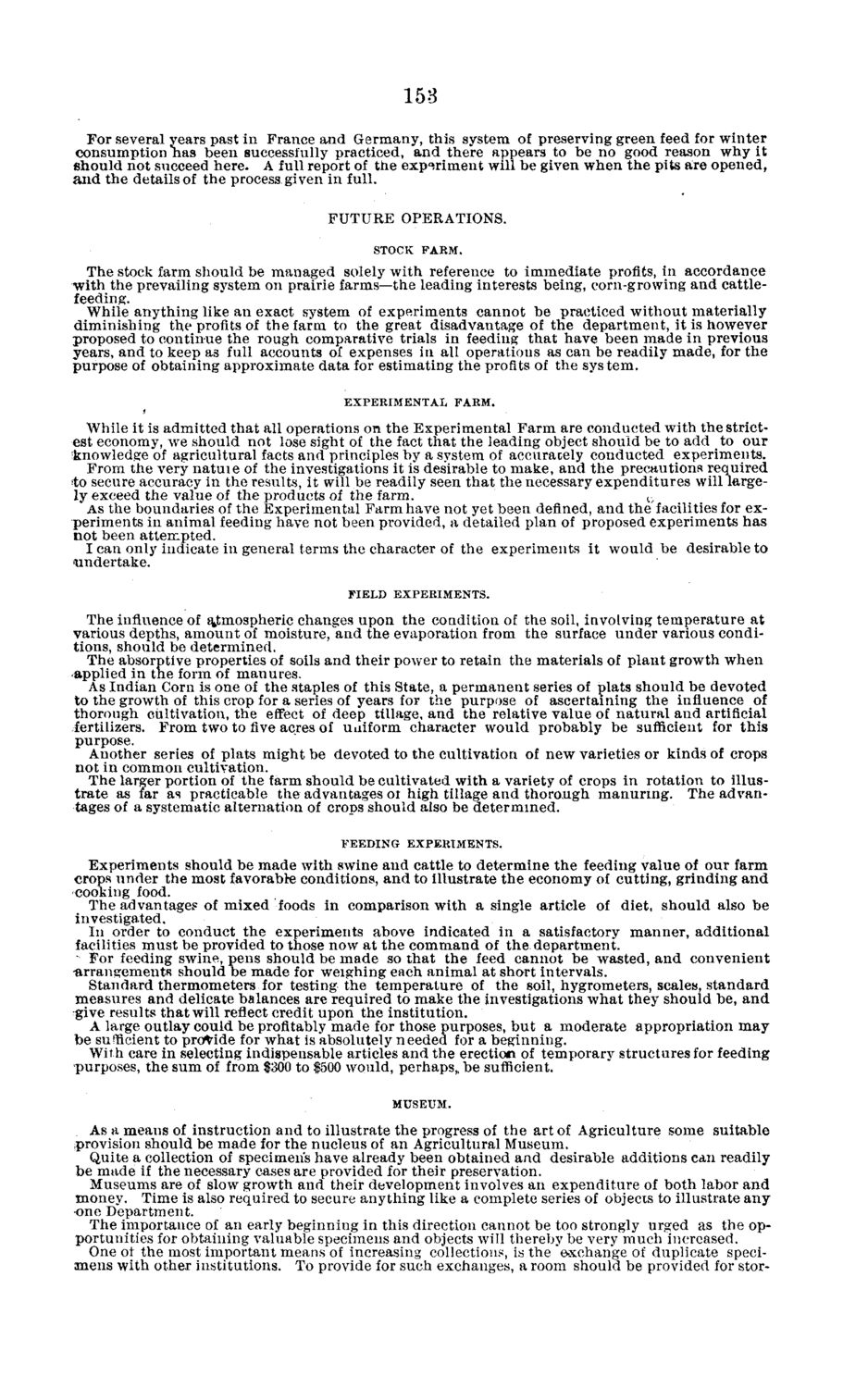| |
| |
Caption: Board of Trustees Minutes - 1876
This is a reduced-resolution page image for fast online browsing.

EXTRACTED TEXT FROM PAGE:
153 For several years past in France and Germany, this system of preserving green feed for winter consumption "has been successfully practiced, and there appears to be no good reason why it should not succeed here. A full report of the experiment will be given when the pits are opened, and the details of the process given in full. FUTURE OPERATIONS. STOCK F A R M . The stock farm should be managed solely with reference to immediate profits, in accordance Tvith the prevailing system on prairie farms—the leading interests being, corn-growing and cattlefeeding. While anything like an exact system of experiments cannot be practiced without materially diminishing the profits of the farm to the great disadvantage of the department, it is however proposed to continue the rough comparative trials in feeding that have been made in previous years, and to keep as full accounts of expenses in all operations as can be readily made, for the purpose of obtaining approximate data for estimating the profits of the system. EXPERIMENTAL FARM. While it is admitted that all operations on the Experimental Farm are conducted with the strictest economy, we should not lose sight of the fact that the leading object should be to add to our knowledge of agricultural facts and principles by a system of accurately conducted experiments. From the very natuie of the investigations it is desirable to make, and the precautions required to secure accuracy in the results, it will be readily seen that the necessary expenditures will largely exceed the value of the products of the farm. ^ As the boundaries of the Experimental Farm have not yet been defined, and the facilities for experiments in animal feeding have not been provided, a detailed plan of proposed experiments has not been attempted. I can only indicate in general terms the character of the experiments it would be desirable to oindertake. FIELD EXPERIMENTS. The influence of atmospheric changes upon the condition of the soil, involving temperature at various depths, amount of moisture, and the evaporation from the surface under various conditions, should be determined. The absorptive properties of soils and their power to retain the materials of plant growth when applied in the form of manures. As Indian Corn is one of the staples of this State, a permanent series of plats should be devoted to the growth of this crop for a series of years for the purpose of ascertaining the influence of thorough cultivation, the effect of deep tillage, and the relative value of natural and artificial fertilizers. From two to five acres of uniform character would probably be sufficient for this purpose. Another series of plats might be devoted to the cultivation of new varieties or kinds of crops not in common cultivation. The larger portion of the farm should be cultivated with a variety of crops in rotation to illustrate as far as practicable the advantages ot high tillage and thorough manuring. The advantages of a systematic alternation of crops should also be determined. FEEDING EXPERIMENTS. Experiments should be made with swine and cattle to determine the feeding value of our farm crops under the most favorable conditions, and to illustrate the economy of cutting, grinding and cooking food. The advantage? of mixed foods in comparison with a single article of diet, should also be investigated. In order to conduct the experiments above indicated in a satisfactory manner, additional facilities must be provided to those now at the command of the.department. - For feeding swine, pens should be made so that the feed cannot be wasted, and convenient -arrangements should be made for weighing each animal at short intervals. Standard thermometers for testing the temperature of the soil, hygrometers, scales, standard measures and delicate balances are required to make the investigations what they should be, and •give results that will reflect credit upon the institution. A large outlay could be profitably made for those purposes, but a moderate appropriation may be sufficient to provide for what is absolutely needed for a beginning. With care in selecting indispensable articles and the erection of temporary structures for feeding purposes, the sum of from $300 to $500 would, perhaps,, be sufficient. MUSEUM. As a means of instruction and to illustrate the progress of the art of Agriculture some suitable provision should be made for the nucleus of an Agricultural Museum. Quite a collection of specimen's have already been obtained and desirable additions can readily be made if the necessary cases are provided for their preservation. Museums are of slow growth and their development involves an expenditure of both labor and money. Time is also required to secure anything like a complete series of objects to illustrate any •one Department. The importance of an early beginning in this direction cannot be too strongly urged as the opportunities for obtaining valuable specimens and objects will thereby be very much increased. One ot the most important means of increasing collections, is the "exchange of duplicate specimens with other institutions. To provide for such exchanges, a room should be provided for stor-
| |